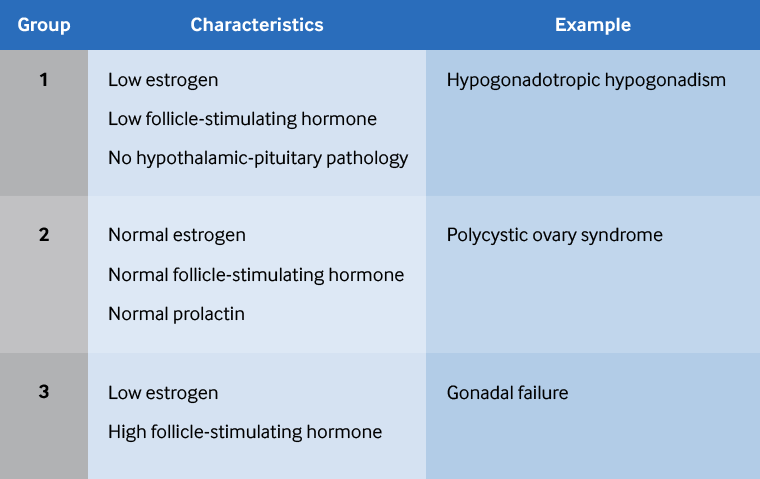Etiology
Endocrinologic and behavioral disorders affect the majority of patients presenting with secondary amenorrhea.[9][10]
Some clinicians prefer to approach the patient with amenorrhea based on the presence or absence of a uterus and breast development (estrogen production). Another well-accepted classification system presented by the World Health Organization divides patients into groups based on endogenous estrogen production, follicle-stimulating hormone levels, prolactin levels, and hypothalamic-pituitary dysfunction.[11] This classification is a guide that eliminates several diagnoses based on initial information. However, further workup is still required.
[Figure caption and citation for the preceding image starts]: World Health Organization classification of amenorrheaCreated by BMJ Knowledge Centre [Citation ends].
Functional
Emotional stress can impair hypothalamic function, resulting in hypogonadotropic hypogonadism. Extreme athleticism, poor dietary habits or eating disorders can affect menstruation.[12]
Premature ovarian failure (POF) or natural menopause
POF should always be considered in a woman of reproductive age who describes amenorrhea, irrespective of the lack of vasomotor symptoms. Reproductive and long-term health outcomes can be further affected if not diagnosed early. Differential causes should be investigated, such as chromosomal anomalies or autoimmune disorders, particularly for women under 40 years of age, although clear mechanisms and conclusive associations have not been reached and approximately 50% of cases remain unexplained. A family history of POF is a major risk factor for idiopathic POF, with the risk increased up to 6-fold in first-degree relatives of women with POF.[13]
POF can result directly from certain chemotherapeutic agents, although menses can resume, depending on age when treated and the therapy administered. It can also occur after pelvic radiotherapy.
Endocrine dysfunction
One of the most common causes of secondary amenorrhea due to ovulatory dysfunction is polycystic ovarian syndrome, however, other endocrine disorders such as hypothyroidism or hyperprolactinemia should also be considered.
Hypopituitarism
Panhypopituitarism, from trauma, surgery, or hemorrhage, can also result in secondary amenorrhea. Other endocrine abnormalities will also likely ensue as a result of these etiologies.
Obstetric or surgical procedures
Reproductive outflow tract obstructions, primarily induced from surgical manipulation, can also cause secondary amenorrhea. Intrauterine synechiae represents one of the more common examples, yet is still relatively infrequent.
Chronic illness
Long-term systemic conditions may affect menses through a number of mechanisms including weight loss and metabolic disorders.
Medication
Various medications can result in an iatrogenic form of amenorrhea, which may be the desired outcome. These include exogenous steroid hormones, primarily in the form of contraception (progestin only or estrogen/progestin compounds). Others include antipsychotic medications that alter the dopaminergic pathways, affecting the GnRH pulse generator.
Substance misuse
Cocaine and opioid misuse, in particular, can cause hypogonadism.
Use of this content is subject to our disclaimer